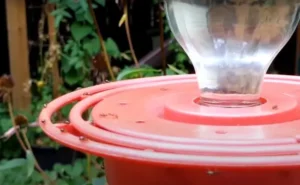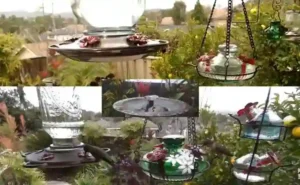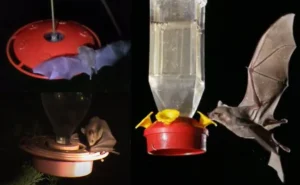Do you get annoyed when bees hog the yummy nectar you put out for hummingbirds?
We love both bees and hummingbirds. They’re great for our gardens and super pretty. But sometimes, bees just won’t stay in their lane, and it becomes a bit of a problem. Bees can also sting people, which is not fun. So, to enjoy watching hummingbirds and keep everyone safe, there are many easy ways.
Choose a bee-proof hummingbird feeder and set up a separate sugar water station for bees. In another way, plant bee-friendly flowers in your garden and select feeders with smaller ports. Also, prepare the nectar that hummingbirds love but bees aren’t crazy about.
Table of Contents
When is the Bee Problem Most Likely to Occur?
The problem of bees attracted to hummingbird feeders is most likely to occur when natural nectar sources are scarce. Bees rely on nectar and pollen from various sources to maintain their colonies and produce honey.
When natural nectar sources are limited, bees may struggle to find enough food to survive and thrive, and then they will be attracted to your hummingbird feeders. It is most likely to happen in hot and dry weather.
Why Bees Are Attracted to Hummingbird Feeders?
Since hummingbirds and bees share a love for sweet things, bees are attracted to hummingbird feeders due to their sugary taste and the lure of nectar. The sweet nectar in hummingbird feeders is like a dessert for bees, and they love stealing it. However, this can be risky for delicate hummingbirds as bees may swiftly attack them.
Balancing the needs of hummingbirds and bees together helps create a safe space for hummingbirds without causing harm to the bees that play a vital role in our ecosystem. When setting up hummingbird feeders in your yard, it’s crucial to understand how to keep bees out of hummingbird feeders, ensuring their safety in the process.
It’s all about finding an excellent balance where everyone gets what they need. Creating a bee-friendly hummingbird feeding area naturally enhances the harmony between pollinators and birdwatchers.
Hummingbirds are not naturally afraid of bees. A few bees probably won’t stop hummingbirds from coming to feeders. But if there are too many bees, it might be hard for the hummingbirds to get to the food, which could keep them away from the feeders. To make bee-free hummingbird feeders and a friendly place for hummingbirds without bothering bees, you can follow these strategies:
If you are a gardener and a hummingbird enthusiast, you take an interest in maintaining a bee-free zone around hummingbird feeders without harming the bees or hummingbirds. You are here at the right place. A lot of people ask me how to keep bees away from hummingbird feeders. In this comprehensive guide, I will discuss all the easy and natural ways to bee-free hummingbird feeders.
Effective Strategies to Deter Bees
Use A Red Hummingbird Feeder
The red color of the feeders can be your natural bee deterrent hummingbird feeders. Using a red hummingbird feeder can help deter bees, as bees are less attracted to the color red. The color red is more attractive to hummingbirds, while bees tend to flock to yellow. That’s why, most hummingbird feeders are red.
It’s important to note that bees are essential pollinators, so the goal is to deter them from the feeder, not to harm them. Using a red hummingbird feeder is a practical and non-harmful way to deter bees and attract hummingbirds.
Along with putting a red hummingbird feeder, you can put some perches to attract hummingbirds too. They need perches to rest and conserve energy between feeding, rather than constantly hovering around the feeder. Hummingbirds cannot hop, so resting on the ground is not safe for them; they need a perch located high above the ground with a wide vantage point in dappled sun.
Stay In The Shade
Placing a hummingbird feeder in a shaded area can make it less attractive to bees. Bees typically feed in full sunlight, so a shaded spot can help keep them away from the feeder.
Some benefits of placing the feeder in a shaded area include:
Use Nectar Guards For Feeders
You can use nectar guards to keep bees and other bugs from getting to the nectar in your hummingbird feeder. Bees can’t get to the nectar through the feeder hole because of nectar guards, which are small barriers. Hummingbirds can still drink from the feeder, though. You can make your nectar guards or buy them.
These nectar guards are easy to attach to the feeder. They have a flexible material that opens when hummingbirds put their beaks in to feed and closes tightly when hummingbirds take out their beaks. It acts as a shield or a protective cover that blocks the access of bees in hummingbird feeders to drink nectar.
Plant A Pollinator Garden
Creating a separate area with flowers that attract bees can divert their attention away from hummingbird feeders. It will be the natural bee repellent for hummingbird feeders. To plant a pollinator garden that attracts bees and diverts their attention from the hummingbird feeders, you must follow these steps:
Don’t Spray Insecticides And Pesticides
Using insecticides and pesticides can harm both bees and hummingbirds, so it’s best to avoid them altogether. Many pesticides, even organic ones, can harm pollinators. Be cautious when using pesticides or insecticides in your garden, and consider alternative methods for controlling pests. Never use harmful substances on or near the feeders.
According to research, the same pesticides contributing to bee declines are likely contributing to hummingbird declines, so it’s essential to be cautious when using pesticides in your garden to ensure a harmonious environment for both bees and hummingbirds.
It is important to find a balance between attracting hummingbirds and keeping bees away. Chemical pesticides should be avoided as they can harm both bees and hummingbirds.
Don’t Use Petroleum Jelly
Using petroleum jelly around hummingbird feeders to deter bees is not recommended. While it may keep insects away, it can also coat hummingbirds’ feathers, and they will not be able to fly properly. This endangers the world’s smallest birds. A hummingbird enthusiast will never try to use these sticky substances to ensure the safety of hummingbird feeders.
Do Not Use Sticky Traps
Be careful with insect traps near your hummingbird feeders. Don’t use sticky traps closer by because they might accidentally catch and hurt the hummingbirds. Use other ways to control insects to keep these lovely birds safe.
Deter Unwanted Bees With Vinegar
vinegar can be used to deter unwanted bees. A mixture of equal parts of water and vinegar can be sprayed around the feeding area to repel bees. Vinegar has a strong scent that bees tend to avoid. However, it’s essential to use this method carefully to prevent any adverse effects on hummingbirds in the area.
How To Keep Bees Off Hummingbird Feeders With Vinegar?
Create a Vinegar Solution:
- Mix equal parts of water and vinegar to make a simple and safe solution.
Fill a Spray Bottle:
- Pour the vinegar solution into a spray bottle for easy application.
Spray Around the Feeding Area:
- Lightly spray the mixture in the areas where you want to discourage bees. Focus on the surroundings of the hummingbird feeders.
Reapply as Needed:
- Depending on the weather and bee activity, you may need to reapply the vinegar solution periodically.
Avoid Spraying Directly on Plants:
- While using the vinegar solution, avoid spraying it directly on plants, as it might affect them negatively.
Monitor Effectiveness:
- Observe the area to see if the vinegar mixture is effective in deterring bees. Adjust the application as needed.
Keep Bees Away With Citrus
Using citrus peels or essential oils can deter bees from approaching hummingbird feeders. Citrus oils, such as orange oil, are effective in repelling carpenter bees. Citrus spray is a natural bee repellent that can be applied on the outer surfaces to prevent bee nesting.
Use Essential Oils (Peppermint, Eucalyptus, and Tea tree oil)
If you want to make sure bees stay away from your hummingbird’s food, you can use specific oils that work well. Bees love the sweet smell of nectar, but they hate the smells of some essential oils, such as:
- Peppermint oil
- Eucalyptus oil
- Tea tree oil
You can put a few drops of any of these oils on a cotton ball or a piece of paper and place it close to the hummingbird feeder. Another way is to mix the oil with some water to make a spray. Just spray it around the feeder. This will help keep the bees away so that the hummingbirds can enjoy their food without any problems.
Divert The Bees’ Attention
If you are still facing the bees taking over the feeder, then you can divert the bees’ attention by placing a separate feeder for bees away from the hummingbird feeder. Fill the bee feeder with a mixture of water and sugar, which is sweeter than hummingbird nectar. If you are still serious about keeping bees away from hummingbird feeders, you must try to divert the bees with the help of a pollination garden full of flowers.
Bees prefer a lower concentration of sugar in their food compared to hummingbirds. Hummingbirds typically prefer flowers that offer mainly sucrose with natural floral nectar. On the other hand, bees and wasps prefer sweeter solutions and a lower concentration of sugar in their food, so install a decoy hummingbird feeder with less sugar concentration in nectar.
To create ideal hummingbird nectar, it is recommended to follow the guidelines provided by experts, which include using refined white sugar and mixing it with water in a 1:4 ratio (e.g., 1 cup of sugar with 4 cups of water) until the sugar is fully dissolved. Hummingbirds can naturally drink nectar that is up to 30% sugar.
Check your feeders for leaks
To keep your hummingbird feeders away from bees, you must check feeders regularly for leaks or drips. These can waste nectar and attract bees. If you see any leaks, figure out what’s causing them and fix them as soon as possible. Look for the signs of wear and tear, especially around the connections.
Tighten any loose parts you find to keep the feeder stable and leak-free. If you spot any worn-out seals or gaskets during your check, replace them. Taking these simple steps will help your hummingbird feeders stay in good shape.
It provides a reliable food source for the birds without inviting the bees to the party. Regularly clean and maintain the hummingbird feeders to prevent the buildup of mold and bacteria.
Dissecting honey bees for tracheal mites
Honey bees swarming feeders can cause problems for hummingbirds. Dissecting honey bees for tracheal mites is not a recommended method to deter bees from hummingbird feeders. This method is used to diagnose tracheal mite infestations in honey bee colonies.
It involves collecting adult bees and dissecting them to expose their tracheae, where the mites live. This method should only be used as a last resort if the bee problem persists and becomes a threat. It is recommended to consult a professional or local beekeeper for assistance.
Pro Tip:
What to consider when buying a new hummingbird feeder?
Whenever I want to buy a new hummingbird feeder, I always look for these important things:
Frequently Asked Questions
What Repels Bees But Not Hummingbirds?
Red hummingbird feeders, citrus peels, essential oils like peppermint, and a lower concentration of sugar in nectar can repel bees while still attracting hummingbirds.
How Do You Make Bee Proof Hummingbird Feeders?
To make bee proof feeders, you can use a red hummingbird feeder, get nectar guards, plug leaks, stay in the shade, relocate frequently, and plant a pollinator garden.
Can Bees Be Kept Away From Hummingbird Feeders?
Yes, bees can be kept away by selecting bee-resistant feeder designs, placing feeders in shaded areas, and using nectar with a higher water-to-sugar ratio.
Why Are Bees Suddenly On My Hummingbird Feeder?
Bees are attracted to the sweet nectar in hummingbird feeders. Factors like the color, scent, nearby flowers, and cleanliness can influence bee attraction.
Conclusion
It is possible to keep bees away from hummingbird feeders without harming them. Using red feeders, placing them in the shade, and employing nectar guards can help. Planting bee-friendly gardens and using natural deterrents like citrus or peppermint oil are good ideas.
Avoid harmful substances like petroleum jelly and traps. Understanding when attracting bees and wasps becomes a problem is also crucial. Hopefully, By implementing these methods, you can create a bee-free environment for hummingbirds to enjoy their nectar.
So, you can enjoy watching hummingbirds while respecting the importance of bees in our ecosystem. With these practical tips to keep bees away from hummingbird feeders, you can see your garden filled with beautiful colors and the flapping wings of delightful hummingbirds.




